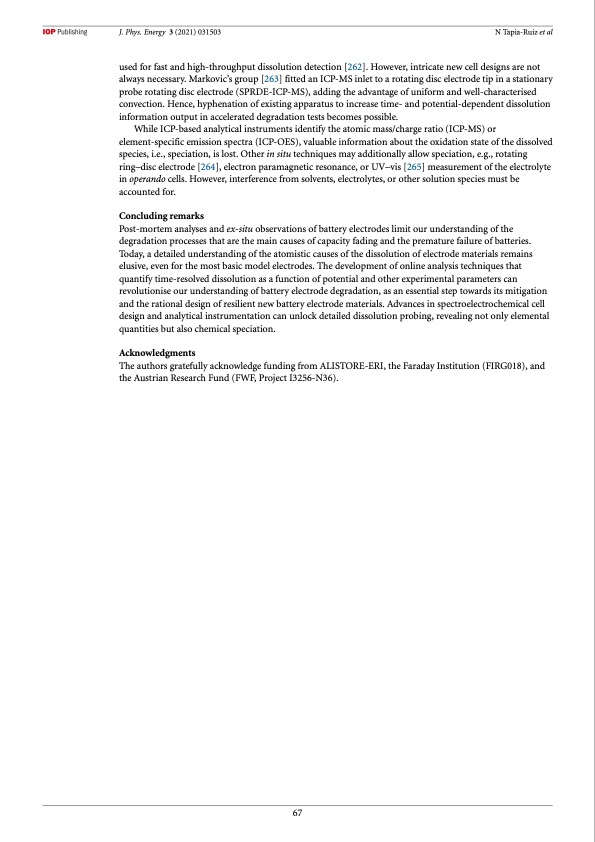
PDF Publication Title:
Text from PDF Page: 068
J. Phys. Energy 3 (2021) 031503 N Tapia-Ruiz et al used for fast and high-throughput dissolution detection [262]. However, intricate new cell designs are not always necessary. Markovic’s group [263] fitted an ICP-MS inlet to a rotating disc electrode tip in a stationary probe rotating disc electrode (SPRDE-ICP-MS), adding the advantage of uniform and well-characterised convection. Hence, hyphenation of existing apparatus to increase time- and potential-dependent dissolution information output in accelerated degradation tests becomes possible. While ICP-based analytical instruments identify the atomic mass/charge ratio (ICP-MS) or element-specific emission spectra (ICP-OES), valuable information about the oxidation state of the dissolved species, i.e., speciation, is lost. Other in situ techniques may additionally allow speciation, e.g., rotating ring–disc electrode [264], electron paramagnetic resonance, or UV–vis [265] measurement of the electrolyte in operando cells. However, interference from solvents, electrolytes, or other solution species must be accounted for. Concluding remarks Post-mortem analyses and ex-situ observations of battery electrodes limit our understanding of the degradation processes that are the main causes of capacity fading and the premature failure of batteries. Today, a detailed understanding of the atomistic causes of the dissolution of electrode materials remains elusive, even for the most basic model electrodes. The development of online analysis techniques that quantify time-resolved dissolution as a function of potential and other experimental parameters can revolutionise our understanding of battery electrode degradation, as an essential step towards its mitigation and the rational design of resilient new battery electrode materials. Advances in spectroelectrochemical cell design and analytical instrumentation can unlock detailed dissolution probing, revealing not only elemental quantities but also chemical speciation. Acknowledgments The authors gratefully acknowledge funding from ALISTORE-ERI, the Faraday Institution (FIRG018), and the Austrian Research Fund (FWF, Project I3256-N36). 67PDF Image | 2021 roadmap for sodium-ion batteries

PDF Search Title:
2021 roadmap for sodium-ion batteriesOriginal File Name Searched:
roadmap-sodium-ion-batteries_031503.pdfDIY PDF Search: Google It | Yahoo | Bing
Salgenx Redox Flow Battery Technology: Salt water flow battery technology with low cost and great energy density that can be used for power storage and thermal storage. Let us de-risk your production using our license. Our aqueous flow battery is less cost than Tesla Megapack and available faster. Redox flow battery. No membrane needed like with Vanadium, or Bromine. Salgenx flow battery
| CONTACT TEL: 608-238-6001 Email: greg@salgenx.com | RSS | AMP |